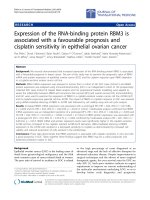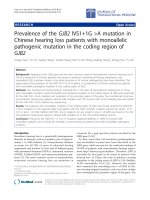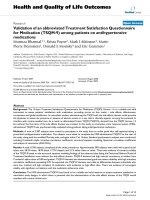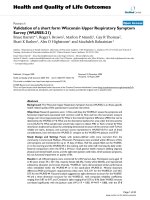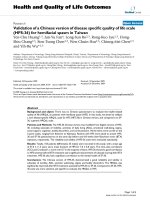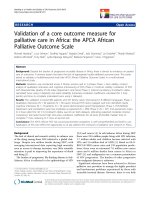báo cáo hóa học:" Validation of a Greek version of the Oral Health Impact Profile (OHIP-14) for use among adults" pdf
Bạn đang xem bản rút gọn của tài liệu. Xem và tải ngay bản đầy đủ của tài liệu tại đây (202.95 KB, 30 trang )
This Provisional PDF corresponds to the article as it appeared upon acceptance. Fully formatted
PDF and full text (HTML) versions will be made available soon.
Validation of a Greek version of the Oral Health Impact Profile (OHIP-14) for use
among adults
Health and Quality of Life Outcomes 2012, 10:7 doi:10.1186/1477-7525-10-7
Vassilia Papagiannopoulou ()
Constantine J. Oulis ()
William Papaioannou ()
George Antonogeorgos ()
John Yfantopoulos ()
ISSN 1477-7525
Article type Research
Submission date 14 February 2011
Acceptance date 14 January 2012
Publication date 14 January 2012
Article URL />This peer-reviewed article was published immediately upon acceptance. It can be downloaded,
printed and distributed freely for any purposes (see copyright notice below).
Articles in HQLO are listed in PubMed and archived at PubMed Central.
For information about publishing your research in HQLO or any BioMed Central journal, go to
/>For information about other BioMed Central publications go to
/>Health and Quality of Life
Outcomes
© 2012 Papagiannopoulou et al. ; licensee BioMed Central Ltd.
This is an open access article distributed under the terms of the Creative Commons Attribution License ( />which permits unrestricted use, distribution, and reproduction in any medium, provided the original work is properly cited.
1
Validation of a Greek version of the Oral Health Impact Profile (OHIP-14)
for use among adults
Vassilia Papagiannopoulou
1
, Constantine J Oulis
2
, William
Papaioannou
2
, George
Antonogeorgos
3
, John Yfantopoulos
1
.
CJO:
JY:
VP:
WP:
GA:
1
School of Law, Economic and Political Sciences, University of Athens, Greece
2
School of Dentistry, University of Athens, Greece
3
Department of Nutrition and Dietetics, Harokopio University, Greece
Corresponding Author:
Assoc. Prof. Constantine J. Oulis
Department of Paediatric Dentistry, Dental School
University of Athens, Greece
Tel: +30 210 7461254
Fax: +30 210 6749263
Email:
2
ABSTRACT
Background: To test the validity of the short form of the Oral Health Impact Profile
(OHIP-14) for use among adults in Greece.
Methods: The original English version of the OHIP-14 was translated using the
forward-backward technique, pilot-tested, and then applied to 211 adults aged 35 years
and above. The questionnaire was filled out during face-to-face interviews conducted
by one dentist, while individuals were asked to undergo a clinical examination. The
internal consistency of the questionnaire was evaluated using Cronbach’s alpha (α)
coefficient and inter-item and item-total correlations. Discriminant and convergent
validities were assessed.
Results: Cronbach’s α was estimated to be 0.90. Inter-item correlations coefficients
ranged from 0.10 to 0.83, while item-total correlations coefficients from 0.44 to 0.76.
Significant associations were found between OHIP-14 and the decayed, missing and
filled teeth (DMFT) and oral hygiene, supporting the ability of the questionnaire to
discriminate between individuals with and without impacts. The OHIP-14 total score
was highly associated with self-perceived oral health status (r
s
=0.57; p=0.01), as well as
with self-assessment of oral satisfaction (r
s
=0.55;p=0.01). Similar results were
observed by investigating the relationship between the latter questions and each domain
score as well as in various sub-groups analyses. Conclusions: The OHIP-14 is a
reliable and valid questionnaire for the assessment of OHRQoL among adults in Greece.
3
Background
Health-Related Quality of Life (HRQoL) is a multi-dimensional concept, which refers
to patients’ physical, psychological and social well-being, and is widely recognised for
the assessment of healthcare outcomes. A factor, however, that can significantly impact
on the construct of HRQoL is the oral health of the individual. Oral Health-Related
Quality of Life (OHRQoL) measures have been widely used in the evaluation of oral
health needs and combined with clinical indicators in order to better identify not only
patients’ symptoms due to oral diseases but also patients’ ability to perform their daily
activities [1,2]. One of the most widely known OHRQoL instruments is the short form
of the Oral Health Impact Profile consisting of 14 items (OHIP-14), which is derived
from the original 49-item version developed by Slade and Spenser [3], for the
measurement of disability and discomfort due to oral conditions. This instrument has
been translated and validated in many languages in different regions of the world [4-13].
In Greece, so far and to our knowledge only one OHRQoL measure has been tested for
validity in an adult population: the Oral Impacts on Daily Performance (OIDP) [14],
while no such attempt regarding the OHIP-14has been undertaken. The latter shows
slightly better correlation with clinical measures of oral health status [15] and appears to
be more useful to discriminate between groups with and without impacts in population
surveys [16].
The objective of this study was to translate the original English version of the OHIP-14
into Greek, and test its validity and reliability for use among Greek adults.
4
Methods
A Greek version of the OHIP-14 was developed and its psychometric properties were
tested in 2 stages: 1) a linguistic translation of the original OHIP-14 into Greek and 2)
completion of a main study to evaluate the construct’s validity.
For the OHIP-14 to be translated, four independent translations were conducted: two
forward and two backward translations. Following comparison of these two forward
translations, to ensure the best interpretation of the original version, the preliminary
Greek version of the OHIP-14 was generated. Afterwards, two independent bilingual
individuals unfamiliar with the original version, whose first language was English, were
asked to conduct the backward translations. The backward translations were then
compared to the original English version to check the similarity of their structure. The
final version of the Greek OHIP-14 was produced after minor modifications were made
according the results of a pilot study. The participants consisted of a convenience
sample of 20 adult patients undergoing a dental check-up in the University of Athens
Dental School. Those presenting with acute dental problems or oral disease were
excluded.
Sample design
The study was conducted in the two metropolitan regions of Athens and Thessaloniki,
where according to the latest Population Census (2001) 45% of the Greek population
resides. The sample units were the same as for the National Pathfinder Survey [17] and
consisted of: i) the examination clinics of the Dental Schools of Athens and
Thessaloniki ii) dental clinics of the Social Insurance Fund of Greece (IKA) in Athens
and Thessaloniki and iii) a selected professional corporation. These units were selected
5
based on: a) the availability of an appropriate middle-age group of the population in one
place, b) the possibility to perform a clinical examination along with completion of a
questionnaire and 3) the population found in these units, in terms of their socio-
demographic strata and oral health condition, were closer to the characteristics of the
General population based on the findings of the National Pathfinder survey [17].
Thus, a consecutive sample of 211 healthy Greek individuals aged 35 yrs and above
visiting the aforementioned sampling units for dental check-up or treatment were
interviewed and clinically examined.
All subjects were acquainted with the purpose of the study, which was ethically
approved by the Research Committee of the School of Dentistry. Out of 250
approached individuals, 211 agreed to participate in the study (a response rate of 84%),
all of who provided informed consent.
A self-administrated questionnaire was designed and one dentist trained in OHRQoL
terms conducted face-to-face interviews. Participants were asked to evaluate on a 5-
point Likert scale (0=never, 1=hardly ever, 2=occasionally, 3=fairly often and 4=very
often) how frequently during the last year had experienced any of the problems assessed
by the 14-item OHIP. Data regarding their socio-demographic profile were also
recorded. Besides OHIP-14, the questionnaire also included items for the assessment of
the different types of construct validity given the absence of a universally accepted
"gold standard"(i.e., self-perceived general and oral health status). After the completion
of the questionnaire, all participants underwent a clinical examination. One experienced
and calibrated dentist recorded the number of decayed, missing and filled teeth
according to the BASCD criteria [18], as well as the Oral Hygiene Index,in accordance
6
with which subjects’ hygiene might be categorized into 3 sub-groups representing good
(0-1.2), fair (1.3-3.0) or poor (3.0-6.0) oral hygiene respectively [19] .
Scoring Method and Data Analysis
The OHIP-14 score was calculated using the additive method. Statistical analysis was
performed using the Statistical Package for Social Sciences (SPSS) v.19.
To assess the reliability of the OHIP-14, Cronbach’s α coefficient was used. In
addition, the impact on the alpha value by the removal of OHIP-14 items (alpha if item
deleted) was evaluated, as well as inter-item and item-total correlations.
Two types of construct validity were used. First, discriminant validity was evaluated by
examining the association between the OHIP-14 total score and participants’ dental
status as assessed by the clinical examination. Mann-Whitney or Kruskal-Wallis test
was used to assess the significance of differences between groups. Secondly, the
convergent validity of the OHIP-14 was assessed by investigating the association
(Spearman’s correlation coefficient (r
s
)) among OHIP-14 total score and each domain
score with self-perceived oral health status (good, fair and poor), and self-assessment of
oral satisfaction (satisfied, dissatisfied). Participants’ perception about their general
health status was also associated with the OHIP-14 total score. Furthermore, sub-group
analyses was performed in order to evaluate possible differences according to the
region, Athens or Thessaloniki or the sampling cluster units - University dental clinics
or social insurance dental clinics (selected corporation professionals due to the small
participants number (n=6) were merged with the social insurance sub-group). Finally,
in order to further validate these results regression analysis was pursued where the
7
dependent variable was the OHIP-14 total score and the independent variables were the
subscales of OHIP-14.
All descriptive and model based results were derived by taking into account the
hierarchical nature of the sample (i.e. individuals clustered in dental clinics) while in
the multivariate model the adjusting factors for gender, residence, education, and
occupational status were taken into account in order to minimize potential confounding
effects.
Results
In total, 211 individuals participated in the study with a mean age of 53.3 years (S.D.
15.4), with the majority being females (52.9%), employed (51.1%), with secondary
education (57%) and living in the capital of Athens (53.8%).The mean value of the
decayed, missing and filled teeth (DMFT) index was 16.8 (S.D. 7.7), with 1.0 (S.D.
1.9) being decayed, 10.8 (S.D. 10.1) missing and 5.0 (S.D. 4.9) filled teeth. Finally,
the mean number of present teeth (including abutment teeth) was estimated to be 21.1
(S.D. 10.1), while 48.5% of the sample had good, 36.3% fair, and 15.2% poor oral
hygiene.
In order to examine the possible design effect of our study, we stratified our analysis
according to the sampling region (Athens or Thessaloniki) and to the sampling cluster
units (university or social insurance dental clinics). The number or defined clusters
were as follows: from Athens, one University dental clinic with 23 participants, and 4
Social Insurance dental clinics with 84 participants (6 participants came from a
professional corporation but due to the small size we merged them with one of the
8
Social Insurance dental clinics). From Thessaloniki, 49 participants came from the
University dental clinic and 49 participants came from two Social Insurance dental
clinics.
By analyzing participants’ OHRQoL data, a high level of oral health impacts was
observed. More specifically, the mean total score of the OHIP-14 was 14.9 (S.D. 10.0),
with the most affected sub-scales being those of Functional Limitation and
Psychological Discomfort both with a mean value of 2.9 (S.D. 2.0). The Physical pain
sub-scale was also highly rated (mean 2.6, S.D. 2.0), followed by the Handicap (mean
2.2, S.D. 1.5) and Physical Disability (mean 2.0, S.D. 1.9) sub-scales. Finally, the
least affected sub-scales were Psychological and Social Disability with mean values 1.4
(S.D. 1.8) and 1.0 (S.D. 1.4) respectively.
Reliability
The Cronbach’s alpha value of the OHIP-14 was estimated to be 0.90, representing an
excellent internal consistency. The removal of one item at a time resulted in lower
alpha values than the original one, supporting the inclusion of all items. By analyzing
the matrix of inter-item correlations (Table 1), a positive correlation between all items
was found. Finally, as it is shown in Table 2, the item-total correlations coefficients
were above 0.20, which is recommended as the minimum value for including an item in
a scale [20]. Sub-group analyses confirmed the stability of the above findings
regardless metropolitan region or dental clinic variations (Table 3).
9
Construct Validity
In Table 4, the results of the assessment of discriminant validity are presented. As
hypothesised, participants’ with a high OHIP-14 score presented a higher number of
decayed and missing teeth and a lower number of natural and filled teeth. All
differences were statistically significant. The ability of the OHIP-14 to discriminate
between groups was also confirmed by evaluating its association with the Oral Hygiene
Index. Participants with poor oral hygiene had higher OHIP scores than those with fair
or good oral hygiene (p<0.01).
With regard to the convergent validity of the OHIP-14, it was estimated that as the
participants’ perceived oral health status changed from poor to good both the mean
OHIP total score and the subscales scores increased (Table 5). All the Spearman’s rank
correlation coefficients were positive and statistically significant. No significant
differences in our results were noted when the effect of the sampling region of the study
(Athens or Thessaloniki) or the sampling cluster units (university or social insurance
dental clinics) was accounted for (Table 6). Moreover, similar results were observed by
associating the OHIP-14 total score with participants’ perception of their general health
status. Those who evaluated their general health status being good, had a lower OHIP-
14 score than those reporting fair or poor general health status, whilst the Spearman’s
rank correlation coefficient was 0.22, significant at the 0.01 level.
The convergent validity of the OHIP-14 was also supported by examining the
relationship among the OHIP-14 total score and each domain score with self-assessment
of oral satisfaction. According to Table 7, in which the findings of this association are
summarized, participants who were not satisfied with their oral health status had
10
statistically significant higher OHIP-14 or sub-scale scores compared to those who
were. Similar patterns of results were observed regarding the convergence validity of
the OHIP-14 with the participants’ perceived oral satisfaction when differences in the
sampling region or in the place where the study conducted were assessed by sub-group
analyses except for the non-significant association for the Handicap sub-scale in the
Athens sample (Table 8).
When examining the validity of the OHIP-14 scale one should not restrict himself to
simple bivariate relationships since some possible confounding factors related to age,
sex, place of residence, education and occupation should be taken into consideration. In
the present analysis multivariate techniques based on regression analysis were adopted
in order to avoid confounding bias. The dependent variable was the OHIP-14 total
score and the independent variables were the subscales of OHIP-14 including the
control variables for age, sex, place of residence, education and occupational status.
From the seven subscales of OHIP-14, the dimension Handicap was selected to be
excluded because of having the lowest correlation coefficient (r=0.545) with OHIP-14
total score. The remaining six dimensions presented much higher correlation
coefficients with OHIP-14 total score ranging from (r=0.672) for Social Disability to
(r=0.867) for Physical Discomfort.
The results of the multivariate analysis with the best possible fit (after examining
several models) are shown in Table 9. The value of adjusted R
2
(coefficient of
determination) reveals that the estimated model explains approximately 99% of the
variance of the dependent variable (OHIP Total Score). All the remaining dimensions
of OHIP-14 (Physical Disability, Social Disability, Physical Discomfort, Physical Pain,
Functional Limitation and Psychological Discomfort) are statistically significant at the
11
p<0.001. In addition the control variables of residence appears to be significant at the
p<0.005 level.
Discussion
This study aimed to generate and evaluate the Greek version of the OHIP-14, in terms
of validity and reliability, for use among adult population. To this effect, the original
English version of the OHIP-14 was translated using the forward-backward technique,
pilot-tested in a convenience group of adults and then applied to a sample of the Greek
population having approximately the same socio-demographic and oral health
conditions, in order for its validity and reliability to be tested. A mean DMFT of 16.8
(S.D. 7.7) of this population (with a mean age of 53.3 years) is between the value of
14.06 and 20.63 found in the National pathfinder survey for the 34-44 and the 65-74-
year-old Greek adults respectively [17]. The findings of our study, which is the first
using the OHIP-14 in Greece confirm that the OHIP-14 is a reliable and valid
instrument for the measurement of OHRQoL among adults in Greece.
The internal consistency of the Greek OHIP-14 was found to be excellent, with the
Cronbach’s alpha coefficient greatly exceeding the minimum recommended value of 0.7
[16,21]. Moreover, the Cronbach’s alpha coefficient reported in our study was slightly
better than those reported by Slade [21] in the original English version, as well as than
those observed by Montero-Martin et al [12] who tested the reliability of the OHIP-14
among adult population in Spain, but the same with that found for Swedish adults [22] .
In addition, lower alpha values were observed by the omission of any of the 14 items,
which provides further evidence about the internal consistency of the present version of
the OHIP-14.
12
The substantial internal consistency of the instrument was also supported by the
findings regarding inter-item and item-total correlations. Specifically, all the inter-item
correlations were positive, and none was high enough for any item to be redundant,
while the item-total correlations coefficients were above the recommended threshold for
including an item in a scale. Similar results have been observed in the Spanish [12] and
the Sinhalese version [23] of the OHIP-14, both evaluating the reliability of the
instrument among adults. As mentioned, the OHIP-14 proved to be a valid measure for
assessing OHRQoL among Greek adults. This was firstly confirmed by its ability to
discriminate between groups with different oral health status, which was objectively
assessed by clinical measures. It was found that the more frequent the presence of oral
conditions such as tooth loss or dental caries the greater the impact on individuals’
OHRQoL. Indeed, it was found in the present study that the presence of less than 25
teeth negatively affects the OHRQoL measures (p<0.01) in adults, confirming a
previous study in the UK [24].
Moreover, a statistically significant association was found between questions aiming to
subjectively evaluate individuals’ oral health status (such as self-perceived oral health
status and self-assessment of oral satisfaction) and OHIP-14 scores. This provided
further evidence for the instrument’s construct validity, since it was shown that the
higher the OHIP-14 total and the subscale scores, the more diminished the OHRQoL,
and thus the poorer the perceived oral health status and satisfaction. Similar findings
were presented for the UK by McGrath and Bedi [24]. Finally, the fact that the
Spearman’s rank coefficient for the association between the OHIP-14 total score and
self-perceived oral health status was higher than those for the association between the
OHIP-14 total score and self-perceived general health status (0.57 vs. 0.22), is not only
13
in accordance with previous findings in the literature [12,25], but also inarguably
supports the specificity of the index.
Concerning the calculation of sample size, a confidence interval of +/-3% is considered
desirable in high quality surveys. By keeping confidence intervals narrow we increase
the expectation of making accurate statistical inferences, but a sample size of more than
1,300 subjects would be necessary to satisfy this principle. However, for validation
studies this large number is impractical. In the current study the sample size of 211
individuals gives us a confidence interval of 6.7%. Indeed, in the literature similar
studies have used similar sample sizes or ever smaller [4,7,9,11,12] whereas other fewer
studies [5,8,23] in larger populations are based on larger sample sizes to validate the
Oral Health Impact Profile (OHIP-14).
Strengths and limitations of the study.
An important strength of this study is that the selected sample was from the two largest
cities of Athens and Thessaloniki, in which the same sample units as for the National
Pathfinder survey [17] were utilized. This ensured that the current sample had
sociodemographic and oral health conditions similar to those found in the survey for
adult Greeks. The second is that the same person who undertook the interview was also
a calibrated dentist. Therefore it was possible to combine quality of life subjective data
with objective assessment of oral health based on clinical examination.
This study has several limitations. First the generalizability of quality of life findings
might be limited to adult population of 35 years and above. Second, due to absence of
“gold standards” in Greece, comparisons are not drawn with other quality of life
instruments.
14
Conclusions
The present findings indicate that the OHIP-14 is a reliable and valid measure to be
used in studies focusing on the measurement of adults’ OHRQoL in Greek adults,
where although several HRQoL studies have been conducted for certain disease
categories [26, 27] little is known on whether the common oral health problems have an
impact on OHRQoL of the individuals of the general population.
15
Competing interests
The authors declare that they have no competing interests.
Authors’ contributions
CJO conceived the study, co-organised the epidemiological oral survey, discussed the
quality of life section and corrected the final draft. PV drafted the manuscript organised
the data selection and performed the validity and reliability statistical analysis. WP
participated in drafting the paper and discussing the relevant literature in the OHRQoL.
AG contributed to the statistical analysis, YJ coordinated the original study, designed
the sampling process, examined the psychometric tests and corrected the final version.
All authors read and approved the final manuscript.
Acknowledgements
This study was part of a 3 year integrated program entitled “Assessment and Promotion
of the Oral Health of the Hellenic Population” coordinated by the Hellenic Dental
Association and sponsored by a Colgate Palmolive Company grant.
16
Tables
Table 1. Reliability analysis based on the OHIP inter-item correlation.
All Correlations are significant at the 0.01 level (2-tailed) except for *two at the 0.05 level (2-tailed).
1 2 3 4 5 6 7 8 9 10 11 12 13 14
1
1.00
2
0.38 1.00
3
0.80 0.46 1.00
4
0.34 0.41 0.35 1.00
5
0.50 0.46 0.53 0.41 1.00
6
0.37 0.35 0.43 0.32 0.38 1.00
7
0.66 0.40 0.68 0.48 0.61 0.49 1.00
8
0.26 0.23 0.28 0.23 0.23 0.74 0.40 1.00
9
0.39 0.26 0.41 0.36 0.31 0.36 0.52 0.43 1.00
10
0.38 0.35 0.41 0.34 0.34 0.35 0.46 0.38 0.83 1.00
11
0.28 0.19 0.34 0.16*
0.21 0.57 0.41 0.51 0.45 0.47 1.00
12
0.34 0.31 0.35 0.25 0.25 0.44 0.39 0.39 0.52 0.59 0.60 1.00
13
0.44 0.29 0.45 0.28 0.43 0.20 0.43 0.10 0.30 0.3 0.21 0.18 1.00
14
0.32 0.33 0.35 0.36 0.27 0.69 0.41 0.63 0.48 0.51 0.62 0.50 0.14*
1.00
17
Table 2: Reliability analysis based on the corrected item-total correlation and
Cronbach’s alpha coefficient if item deleted.
Impact Item
Corrected Item -
Total Correlation
Cronbach’s Alpha
if Item Deleted
1 Difficult to pronounce words 0.65 0.89
2 Worsened taste 0.52 0.89
3 Pain 0.70 0.89
4 Uncomfortable to eat 0.50 0.89
5 Self-conscious 0.58 0.89
6 Feel tensed 0.65 0.89
7 Diet unsatisfactory 0.76 0.88
8 Interrupted meals 0.54 0.89
9 Difficult to relax 0.64 0.89
10 Embarrassed 0.64 0.89
11 Irritable 0.56 0.89
12 Difficult to do jobs 0.57 0.89
13 Life less satisfying 0.44 0.89
14 Totally unable to function 0.64 0.89
18
Table 3: Reliability analysis based on the corrected item-total correlation and Cronbach’s alpha coefficient if item deleted according to the
sampling region and the sampling cluster units of the study.
Athens Thessaloniki
University Dental
Clinic
Social Insurance
Dental Clinic
Impact Item
Corrected
Item -
Total
Correlation
Cronbach’s
Alpha
if Item
Deleted
Corrected
Item -
Total
Correlation
Cronbach’s
Alpha
if Item
Deleted
Corrected
Item –
Total
Correlation
Cronbach’s
Alpha
if Item
Deleted
Corrected
Item –
Total
Correlation
Cronbach’s
Alpha
if Item
Deleted
1. Difficult to pronounce words 0.64 0.88 0.66 0.85 0.66 0.91 0.64 0.88
2. Worsened taste 0.50 0.88 0.36 0.87 0.54 0.92 0.51 0.88
3. Pain 0.73 0.88 0.68 0.85 0.77 0.91 0.66 0.88
4. Uncomfortable to eat 0.43 0.88 0.34 0.87 0.63 0.92 0.41 0.89
5. Self-conscious 0.48 0.88 0.60 0.85 0.65 0.92 0.54 0.88
6. Feel tensed 0.61 0.88 0.70 0.85 0.74 0.91 0.60 0.88
7. Diet unsatisfactory 0.72 0.88 0.72 0.85 0.81 0.91 0.73 0.87
8. Interrupted meals 0.55 0.88 0.51 0.86 0.58 0.92 0.52 0.88
9. Difficult to relax 0.69 0.88 0.43 0.86 0.69 0.91 0.60 0.88
10. Embarrassed 0.67 0.88 0.42 0.86 0.69 0.91 0.62 0.88
11. Irritable 0.57 0.88 0.46 0.86 0.58 0.92 0.56 0.88
12. Difficult to do jobs 0.61 0.88 0.32 0.87 0.46 0.92 0.65 0.88
13. Life less satisfying 0.16 0.89 0.51 0.86 0.54 0.92 0.39 0.89
14. Totally unable to function 0.62 0.88 0.57 0.86 0.73 0.91 0.58 0.88
19
Table 4. Discriminant validity of the OHIP-14 based on the clinical status of the
subjects.
Variable (number of cases)
OHIP-14
Mean (S.D.*)
Test
Number of teeth:
<25 teeth 17.3 (11.3)
≥25 teeth 12.4 (7.6)
Mann-Whitney
P<0.01
Number of decayed teeth:
Dt<2 13.7 (9.4)
Dt≥2 18.2 (10.7)
Mann-Whitney
P<0.05
N
umber of missing teeth:
Mt<8 12.8 (8.0)
Mt≥8 17.7 (11.5)
Mann-Whitney
P<0.01
Number of filled teeth:
Ft<6 16.3 (10.9)
Ft≥6 12.8 (7.7)
Mann-Whitney
P<0.05
Oral Hygiene Index (OHI-s)
distribution
OHΙ-s=0.0-1.2 (good oral
hygiene)
11.9 (8.5)
OHΙ-s=1.3-3.0 (fair oral hygiene) 16.0 (9.6)
OHΙ-s=3.1-6.0 (poor oral
hygiene)
18.8 (10.7)
Kruskall-Wallis
P<0.01
S.D.= Standard Deviation
20
Table 5. Convergent validity of the OHIP-14: Mean scores and Spearman’s rank
Correlation coefficients among the OHIP-14 and subscale scores and self-
perceived Oral health status.
Self-perceived oralhealth status
Subscales
All subjects
n=210
Mean (S.D.)
Good
n=103
Mean (S.D.)
Fair
n=83
Mean (S.D.)
Poor
n=24
Mean (S.D.)
r
s
Functional
limitation
2.9 (2.0) 2.1 (1.7) 3.1 (1.6) 5.5 (1.7) 0.45*
Physical pain
2.6 (2.0) 1.9 (1.6) 2.9 (1.6) 4.5 (2.3) 0.39*
Psychological
discomfort
2.9 (2.0) 2.0 (1.6) 3.3 (1.9) 4.8 (1.7) 0.47*
Physical
disability
1.4 (1.8) 0.8 (1.5) 1.5 (1.6) 3.5 (2.4) 0.41*
Psychological
disability
2.0 (1.9) 1.0 (1.2) 2.5 (1.9) 4.5 (1.7) 0.57*
Social
disability
1.0 (1.4) 0.5 (1.1) 1.2 (1.3) 2.5 (2.3) 0.39*
Handicap
2.2 (1.5) 1.6 (1.3) 2.5 (1.3) 3.6 (1.4) 0.45*
OHIP-14
14.9 (10.0) 9.8 (7.4) 17.2 (7.6) 29.0 (10.1) 0.57*
*Correlation is significant at the 0.01 level (2-tailed).
21
Table 6. Convergent validity of the OHIP-14: Mean scores and Spearman’s rank
Correlation coefficients among the OHIP-14 and subscale scores and self-
perceived Oral health status according to the sampling region and the
sampling cluster units of the study.
Self-perceived oral health status
Subscales
All subjects
n=210
Mean (S.D.)
Good
n=103
Mean (S.D.)
Fair
n=83
Mean (S.D.)
Poor
n=24
Mean (S.D.)
r
s
Athens
Functional
limitation
3.4 (2.0) 2.5 (1.6) 3.4 (1.7) 5.7 (1.9) 0.37*
Physical pain
3.2 (1.8) 2.5 (1.4) 3.3 (1.5) 5.1 (2.2) 0.27*
Psychological
discomfort
4.4 (2.3) 3.3 (1.6) 4.4 (1.9) 7.2 (2.2) 0.45*
Physical
disability
1.8 (1.7) 1.0 (1.4) 1.8 (1.3) 3.9 (2.1) 0.40*
Psychological
disability
2.5 (1.8) 1.4 (1.2) 2.6 (1.5) 4.8 (1.4) 0.51*
Social
disability
1.4 (1.6) 0.8 (1.2) 1.4 (1.2) 3.0 (2.3) 0.35*
Handicap
1.9 (0.8) 1.9 (0.9) 2.0 (0.8) 2.0 (1.0) 0.02
OHIP-14
18.8 (9.5) 13.3 (6.5) 18.8 (6.6) 31.6 (9.2) 0.47*
Thessaloniki
Functional
limitation
2.3 (1.8) 1.7 (1.7) 2.6 (1.5) 4.8 (0.4) 0.41*
Physical pain
1.9 (1.7) 1.5 (1.6) 2.4 (1.8) 2.6 (1.5) 0.35*
Psychological
discomfort
2.4 (2.3) 1.7 (2.0) 3.4 (2.4) 4.2 (2.6) 0.43*
Physical
disability
0.8 (1.2) 0.4 (0.9) 1.4 (1.4) 1.8 (1.1) 0.43*
Psychological
disability
1.3 (1.9) 0.5 (0.9) 2.4 (2.3) 3.4 (2.5) 0.40*
Social
disability
0.5 (1.0) 0.3 (0.8) 0.9 (1.3) 0.6 (0.9) 0.34*
Handicap
1.2 (1.1) 0.9 (1.0) 1.5 (1.1) 1.6 (0.9) 0.36
OHIP-14
10.2 (8.5) 6.9 (6.9) 14.6 (8.4) 19.0 (7.0) 0.52*
University Dental Clinic
Functional
limitation
2.9 (2.2) 1.8 (1.8) 3.0 (1.9) 5.1 (2.1) 0.42*
Physical pain
2.5 (2.3) 1.3 (1.6) 3.0 (2.2) 4.7 (2.5) 0.51*
Psychological
discomfort
3.4 (2.8) 1.8 (2.1) 4.0 (2.1) 7.1 (2.7) 0.63*
22
discomfort
Physical
disability
1.4 (1.8) 0.5 (1.3) 1.8 (1.6) 3.6 (2.1) 0.53*
Psychological
disability
2.1 (2.0) 0.8 (1.1) 2.8 (1.7) 4.8 (1.5) 0.67*
Social
disability
1.0 (1.4) 0.6 (1.2) 1.0 (1.1) 2.7 (1.8) 0.42*
Handicap
1.4 (1.0) 1.0 (1.1) 1.7 (1.0) 2.0 (0.7) 0.37*
OHIP-14
14.7 (11.3) 7.9 (8.1) 17.4 (7.7) 30.0 (9.9) 0.66*
Social Insurance Dental Clinic
Functional
limitation
2.9 (1.9) 2.1 (1.7) 3.1 (1.6) 5.8 (1.5) 0.47*
Physical pain
2.7 (1.7) 2.2 (1.6) 2.8 (1.3) 4.4 (2.2) 0.32*
Psychological
discomfort
3.6 (2.3) 2.7 (1.9) 4.0 (2.2) 6.1 (2.5) 0.44*
Physical
disability
1.3 (1.5) 0.7 (1.2) 1.5 (1.2) 3.4 (2.2) 0.44*
Psychological
disability
1.9 (1.9) 1.0 (1.2) 2.4 (1.9) 4.3 (1.9) 0.51*
Social
disability
1.0 (1.5) 0.4 (0.9) 1.3 (1.3) 2.4 (2.6) 0.38*
Handicap
1.7 (1.0) 1.5 (1.1) 1.9 (0.9) 0.9 (1.2) 0.15*
OHIP-14
15.0 (9.3) 10.7 (9.0) 17.1 (7.6) 28.3 (10.6) 0.52*
*Correlation is significant at the 0.01 level (2-tailed).
23
Table 7. Convergent validity of the OHIP-14: Mean scores and Spearman’s rank
correlation coefficients among the OHIP-14 and subscale scores and self-
assessment of oral satisfaction.
Self-assessment of oral satisfaction
Subscales
All subjects
n=202
Mean (S.D.)
Satisfied
n=127
Mean (S.D.)
Dissatisfied
n=75
Mean (S.D.)
r
s
Functional limitation
2.9 (2.0) 2.2 (1.7) 4.0 (2.0) 0.43*
Physical pain
2.6 (2.0) 2.1 (1.7) 3.5 (1.9) 0.36*
Psychological discomfort
2.9 (2.0) 2.1 (1.7) 4.1 (1.8) 0.47*
Physical disability
2.0 (1.9) 1.2 (1.4) 3.4 (2.0) 0.53*
Psychological disability
1.4 (1.8) 0.9 (1.5) 2.3 (2.0) 0.40*
Social disability
1.0 (1.4) 0.5 (1.0) 1.7 (1.7) 0.40*
Handicap
2.2 (1.5) 1.6 (1.3) 3.1 (1.3) 0.48*
OHIP-14
14.9 (10.0) 10.6 (7.5) 22.3 (9.4) 0.55*
*Correlation is significant at the 0.01 level (2-tailed).
24
Table 8. Convergent validity of the OHIP-14: Mean scores and Spearman’s rank
correlation coefficients among the OHIP-14 and subscale scores and self-
assessment of oral satisfaction by the sampling region and the sampling
cluster units of the study.
Self-assessment of oral satisfaction
Athens
Subscales
All subjects
n=202
Mean (S.D.)
Satisfied
n=127
Mean (S.D.)
Dissatisfied
n=75
Mean (S.D.)
r
s
Functional limitation
3.4 (2.0) 2.7 (1.6) 4.2 (2.1) 0.37*
Physical pain
3.2 (1.8) 2.7 (1.5) 3.4 (1.7) 0.27*
Psychological discomfort
4.4 (2.3) 3.4 (1.7) 5.4 (2.4) 0.45*
Physical disability
1.8 (1.7) 1.1 (1.4) 2.6 (1.9) 0.40*
Psychological disability
2.5 (1.8) 1.6 (1.3) 3.4 (1.7) 0.51*
Social disability
1.4 (1.6) 0.9 (1.2) 2.0 (1.8) 0.35*
Handicap
1.9 (0.8) 1.9 (0.9) 2.0 (0.9) 0.02
OHIP-14
18.8 (9.5) 14.3 (6.8) 23.4 (9.7) 0.47*
Thessaloniki
Functional limitation
2.3 (1.8) 1.7 (1.6) 3.7 (1.6) 0.41*
Physical pain
1.9 (1.7) 1.5 (1.6) 2.9 (1.5) 0.35*
Psychological discomfort
2.4 (2.3) 1.8 (2.0) 4.3 (2.3) 0.43*
Physical disability
0.8 (1.2) 0.4 (0.9) 2.0 (1.4) 0.43*
Psychological disability
1.3 (1.9) 0.7 (1.2) 3.3 (2.6) 0.40*
Social disability
0.5 (1.0) 0.3 (0.8) 1.2 (1.4) 0.34*
Handicap
1.2 (1.1) 0.9 (1.0) 1.9 (1.0) 0.36*
OHIP-14
10.2 (8.5) 7.5 (6.6) 19.2 (8.1) 0.52*
University Dental Clinic
Functional limitation
3.4 (2.0) 1.8 (1.7) 4.0 (2.2) 0.44*
Physical pain
3.2 (1.8) 1.5 (1.8) 3.8 (2.2) 0.52*
Psychological discomfort
4.4 (2.3) 1.8 (1.8) 5.6 (2.6) 0.66*
Physical disability
1.8 (1.7) 0.6 (1.2) 2.6 (2.0) 0.55*
Psychological disability
2.5 (1.8) 0.9 (1.1) 3.7 (2.0) 0.58*
Social disability
1.4 (1.6) 0.4 (1.0) 1.9 (1.6) 0.49*
Handicap
1.9 (0.8) 1.1 (1.0) 1.9 (0.9) 0.42*
OHIP-14
18.8 (9.5) 8.1 (6.9) 23.6 (10.0) 0.67*
Social Insurance Dental Clinic




